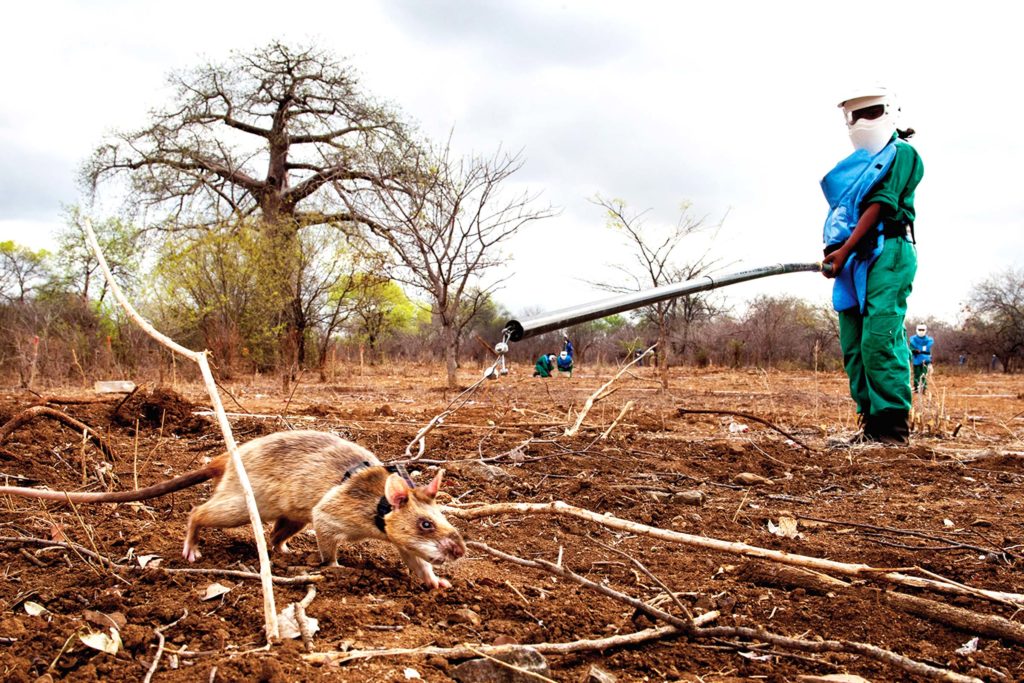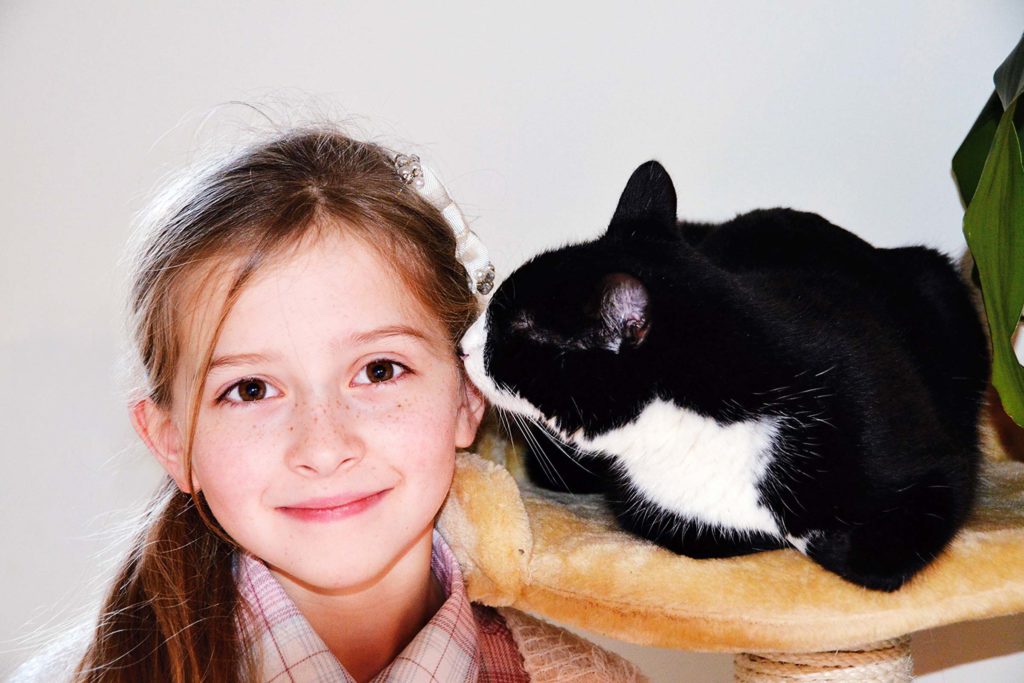Did you ever imagine an animal could save your life? Meet some four-legged friends who’ve gone far beyond the call of duty to save their owners, lost kids, and even an entire continent.
Giant Rats Sniff out Danger


Rats traditionally get a bad rap. We tend to think of them as disease-spreading vermin and like to give them a wide berth. But a crack team of skilled rats has already saved thousands of human lives in Tanzania, Angola and Mozambique—and Cambodia is next on the list.
Belgian organization APOPO is training giant African pouched rats to detect two of Africa’s cruelest menaces. The first is landmines. When civilians have to risk their lives just to fetch water or farm their land, they’re locked into poverty and development is impossible. Wanting to find a local, affordable solution, APOPO founder Bart Weetjens remembered the pet rodents he’d kept as a boy in Belgium. He knew rats were intelligent, sociable, and teachable. They were also in plentiful supply and relatively cheap to train.
APOPO’s heroic rats are also on the front line against Africa’s desperate TB crisis, where clinics are overwhelmed and diagnostic TB tests often inaccurate. (Globally, around 1.5 million people die from TB every year, and every untreated patient can infect up to a dozen other people.)
The rodents are socialized as pups and then trained so that the sound of a clicker means food, and they know that they need to search for the target scent to earn their reward. (Peanut and banana mash is the favorite.) They’re trained to sniff out either TNT explosives (contained in mesh tea-balls or in deactivated landmines) or TB (using sputum samples from patients suspected to be infected). Mine-detection rats complete their nine-month training on a field planted with both deactivated and live landmines.
Since 2007, the rats—which live up to eight years in captivity—have detected over 56,000 landmines and other explosives. The four-legged explosives experts are so light-footed, there hasn’t been a single casualty.
They’ve also screened almost 312,000 TB samples and detected over 8,000 cases that the public clinics missed. While it takes a lab technician all day to evaluate 20 samples, a rat can get it done in just ten minutes. Weetjens adds, “It’s so beautiful to see our rat trainers and their HeroRATs working jointly for a better world.”
Beloved Pet Dies Rescuing Family from Fire

 It seemed like any other day when fitness instructor Chantelle Lister set off to work at 7 a.m. It was the school holidays, so her daughters Loren and Mollie, 17 and six, and 11-year-old son Charlie were still asleep in bed.
It seemed like any other day when fitness instructor Chantelle Lister set off to work at 7 a.m. It was the school holidays, so her daughters Loren and Mollie, 17 and six, and 11-year-old son Charlie were still asleep in bed.
But within an hour, the family home in Kettering, Northamptonshire, England, went up in flames. The fire started in the conservatory and lethal smoke from the uPVC windows started filling the ground floor while the youngsters slept.
Thankfully, the family’s beloved dog Bailey rushed to their rescue. Despite the thick smoke starting to engulf the staircase, the four-year-old Terrier-mix made his way upstairs and kept barking and scratching at Loren’s door until she woke up.
Loren opened the door to thick black smoke streaming up the stairs and the sound of smashing glass. Struggling to breathe, the teenager ran into her siblings’ room and managed to get the terrified children out through a bedroom window and onto a flat roof.
After successfully raising the alarm, Bailey scampered back downstairs to try to get out. Tragically, he was trapped in the burning house.
“The firemen pulled Bailey out and tried to resuscitate him, but he was dead,” Chantelle says. “They put a blanket over him and I kept thinking, ‘That could have been one of my children.’ Bailey was such a character and so loving. The children wouldn’t be here without him. He’s my hero and I’m eternally grateful to him.”
Dogs Team Up to Save Drowning Toddler

 They’re tough breeds and they have the rough-and-tumble names to match. But free-spirited Aussie dogs Tank the Rottweiler-cross and Muck the Staffie-cross instinctively knew when a small child was in danger, and their protective natures averted a tragedy.
They’re tough breeds and they have the rough-and-tumble names to match. But free-spirited Aussie dogs Tank the Rottweiler-cross and Muck the Staffie-cross instinctively knew when a small child was in danger, and their protective natures averted a tragedy.
One December afternoon, Georgie Hillier thought her two-year-old son Max was playing in the back garden of their home in rural Queensland, Australia. But when she went to check, there was no sign of Max or their dog Tank. When she couldn’t find them, she jumped in her car and started scouring the neighboring property. She was frightened her son could have fallen into one of the dams or reservoirs.
Then she found Tank with the neighbor’s dog Muck. They were both running around the dams, barking furiously and covered in mud and slime.
“I just panicked. I was running around, checking the sides of the dams,” Georgie told Sara Hicks from radio station ABC Local. While she kept searching, a neighbor called the police. Eventually, a woman who had found Max heard Georgie’s calls and brought the unharmed toddler out to her.
There was no one there to witness what exactly happened, but Michael Beattie from the Royal Society for the Prevention of Cruelty to Animals takes up the story. “When the police arrived on the scene, they saw quite distinct drag marks. It was apparent that young Max had actually been pulled out of the dam by one of the dogs—most likely Tank. Max was making moves to go back into the dam and Muck was virtually heading him off at the pass. It was the police’s opinion that the only way that Max was rescued from drowning was by the two dogs.”
For saving the toddler’s life, the daring duo received the RSPCA’s prestigious Purple Cross award for bravery—plus two very large bones.
Adopted Cat Moonlights as a Night Nurse

 Much as we love them, cats are not known for acts of altruism. So meet Pippa, an extremely unusual feline.
Much as we love them, cats are not known for acts of altruism. So meet Pippa, an extremely unusual feline.
The black-and-white cat was dumped in a box outside a shop and rehomed by the British RSPCA to the Jansa family in Whitstable, Kent. They were charmed by her gregarious character—but never guessed she’d become a lifesaver.
Eight-year-old Mia Jansa had type one diabetes and had become a dab hand at testing her blood throughout the day, as well as having something to eat or drink to restore her blood-sugar levels. But the danger was at night. Mia was prone to having hypoglycemic episodes when asleep and, left untreated, a hypo can lead to a coma, medical complications and even death.
Soon after she was adopted, Pippa went into Mia’s bedroom in the middle of the night and woke her up. When the child tested her blood sugar levels, she found they were dangerously low. Ever since, Pippa regularly visits Mia at night. If she can’t get her to wake up, she raises the alarm.
“Pippa does this of her own accord,” says Pippa’s mother Laura. “We don’t reward her with food because we don’t want to encourage false alarms, but she gets plenty of cuddles instead. It gives me extra peace of mind to know someone else is keeping an eye on Mia.”
source:rd.com
